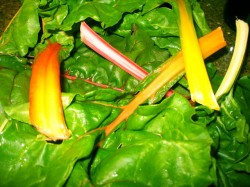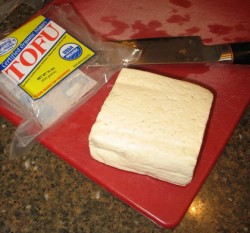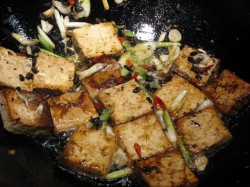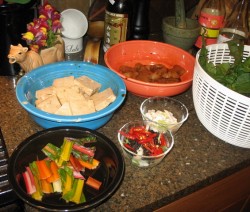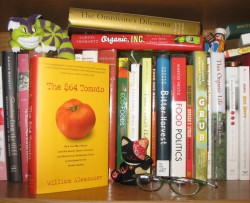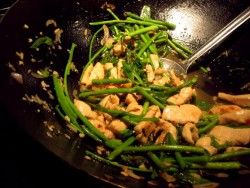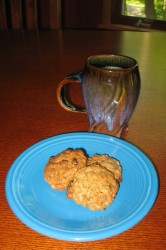Local Produce Find: Bright Lights Chard
It isn’t often that I come across a vegetable that I have not yet tried, but when I do, I nearly always buy some, cook it and see what it tastes like.
Most of the time, I like it pretty well, but sometimes, I find something that I just love.
Chard is one of those “I just love” vegetables.
Why have I never had chard until this year?
I have no ruddy idea, really, except that it was not one of the greens we grew when I was a kid, so we never cooked it, so I never ate it. Then, I also have had to contend with a string of folks with whom I live not being the most enthusiastic eaters of greens in the world, so that put a damper on the, “let’s just try it and see what happens” mode of culinary experimentation that I favor. It has only been recently that Zak has been willing and even thrilled with trying new greens, at least, so long as they are stir-fried.
So, when I bought the chard two weeks ago that I used in my Ten Steps to Better Chicken From a Wok post, I actually didn’t know it was chard. I just thought it looked good. I found that it also tasted good.
Last week at the farmer’s market, when I saw “Bright Lights” chard, I nabbed it up, knowing full well what it was, because I had seen it in seed catalogues for the past couple of years and drooled over the gorgeous colors of the ribs and veins of the leaves. They are lovely, aren’t they? Red, yellow, orange and fuschia, all framed by brilliant emerald green. This chard is pyschedelic in form, if not in effect–it is dressed in the colors Goldie Hawn used to sport in her minidresses on “Laugh-In.” (I am showing my age, am I not?)
Of course, I had to buy it and figure out a stir-fry to feature it in. It was too stained-glass pretty to pass by.
I was in a tofu mood last night, so I pulled out a package of Spring Creek and decided to cook that along with the greens. I added a chicken breast for Zak and Morganna who do not always want just tofu, and then seasoned it all with scallions and green garlic from the farmer’s market, as well as three of the Thai dragon chiles I had in the freezer from last fall’s market growers.
And I -had- to add some fermented black beans. They add so much flavor to the tofu, and their funkiness really compliments the earthy quality of the chard. Besides, I love them with chicken, too.
This particular brand of tofu is great for stir frying, because it really is extra firm, so much so that one needn’t press it to push out the water that softens it. It is firm enough to just take from the package, slice up into whatever shapes you like, marinate and then stir fry. Of course, because I was going to be stir frying with chicken, meant that I had to get creative with how to put the dish together–if you stir fry the chicken and then add the tofu, the chicken will get over done while the tofu is underdone, and if you stir hard enough to move the chicken, the tofu gets bunged up and falls apart, even if it is extra firm. Besides, cooking the two at once overcrowds and cools down the wok and that is never, ever a good thing.
What to do?
Cook in stages, obviously. Which is what I did–I put the aromatics in first, then the marinated tofu, into a single layer on the bottom of the wok. When the bottom was browned to my satisfaction, I flipped the tofu over once, let it brown on the second side, and then scooped it all into the serving bowl to wait. I left as many aromatics as were not clinging to the tofu in the wok as I could, and then threw in the chicken and cooked as normally. Once the chicken was nearly done, in went the chard stems (I cook the stems a bit longer so they will be tender crisp, while the leaves are velvety-wilty–if you put them in together, the stems will be underdone or the leaves overdone) then, added the tofu back in just before I put in the chard leaves, and finished off the dish.
It is all a matter of timing, prioritizing and paying attention to your ingredients.
The finished dish was admirable, and most of it was eaten. The tofu was creamy on the inside, with a bit of crisp laciness on the outside; the chicken was tender and steamy and the chard stems were crisp and watery, and retained their lovely colors, while the leaves were rich on the tongue. The use of dark soy sauce in conjunction with the fermented black beans, scallions and garlic made a deeply flavored sauce that blanketed each bit of food with a clinging coat of deep flavor, while still allowing the natural flavors of the ingredients to shine through.
It was definately a good experiment.
Now I just have to figure out a way to make chard as a side dish to a Western style meal. Maybe sauteed with garlic, scallions and olive oil with a dash of balsamic vinegar? That might be nice.
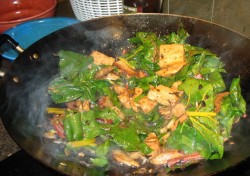
Tofu, Chicken and Chard Stir-Fry
Ingredients:
16 ounces extra firm tofu
2 tablespoons dark soy sauce
1 teaspoon thin soy sauce
1 1/2 tablespoons cornstarch
1 boneless skinless chicken breast, trimmed and cut into 1″X1/2″ slices
1 tablespoon dark soy sauce
1 tablespoon Shao hsing wine
1 teaspoon honey
2 tablespoons cornstarch
3 tablespoons peanut or canola oil
6 stalks green garlic, trimmed and thinly sliced on the diagonal–white and light green parts
6 scallions, white and light green parts sliced thinly on the diagonal
3 Thai dragon chiles, thinly sliced on the diagonal
2 tablespoons lightly crushed fermented salted black beans
2 tablespoons shao hsing wine
1/2 pound chard, big stems cut into 1″ long pieces, and kept separate; leaves cut into 2″ square pieces
1/4 cup chicken broth
1/2 teaspoon sesame oil
Method:
Cut tofu block into slices, about 1/2 inch thick and 1 1/2″ square.
Mix together first measure of soy sauces and cornstarch to form a thick, dark paste, and rub into the tofu slices and then pour the rest of the thick marinade over them. Set aside to marinate for at least twenty minutes.
Toss chicken pieces with the soy sauce, wine, honey, and cornstarch, and allow to marinate twenty minutes.
Heat wok until it smokes. Add oil and heat until it shimmers–about thirty seconds to a minute.
Add the garlic, scallions, chiles and black beans and stir and fry for about thirty seconds. Slide most of the aromatics up the sides of the wok and add tofu in a single layer to the bottom of the wok. (IF there is any liquid marinade left–reserve it.) Allow to sit undisturbed to brown on the bottom–about a minute and a half. When it is brown, flip over the tofu and allow other side to brown–about a minute. When both sides are brown, remove tofu to serving dish and set aside. (Try to keep as many aromatics in the wok as possible!)
Add chicken to wok, settle it into a single layer, and lay aromatics over it. Allow to sit undisturbed until it browns–about a minute. When it browns, begin stir frying as is normal, until chicken is halfway done. At this point, add the second quantity of wine, and deglaze wok. When chicken is nearly done, add in chard stalks and stir fry for about thirty seconds. Add tofu back to wok, with any aromatics that came with it, stir fry gently for about twenty seconds.
Add chard leaves and any liquid marinades from the tofu and chicken and the chicken broth. Stir fry gently, trying to get the hot chicken, tofu and chard stems on top of the leaves, and as soon as leaves wilt, turn off heat, season with sesame oil, and scrape into a warmed serving bowl.
Serve with steamed rice.
The Locavore’s Bookshelf: The $64 Tomato
When I started this series of book reviews last August, I chose titles that I assumed folks who wanted to eat locally would want to know about, including Brian Halweil’s Eat Here and Gary Paul Nabhan’s Coming Home to Eat. Both of these books are specifically about local foodsheds and the process by which individuals and groups are working towards creating sustainable alternatives to the typical American grocery-store, processed food mentality. The very first book I chose to highlight, Joan Dye Gussow’s This Organic Life, is also specifically about the issue of eating locally, in that Gussow set herself the challenge of eating only what she could cultivate on her small plot of land and buy from local growers, and succeeded in doing so for years.
This time around, however, I am moving a little farther afield. Instead of only focusing on the issue of eating locally, I want to draw readers’ attention to books that would be of use to those who want to eat locally, by illuminating issues of sustainability, food, organic methods and gardening in general.
The $64 Tomato, by William Alexander, is a book about gardening.
Actually, it is a book about one man’s obsession, and that would be his garden. In the course of the book we get to follow the development of his obsession from its inception as his dream of growing a miniature organic apple orchard in New York state, to its transformation as his desire to grow all of the organic vegetables his family could eat, to the reality of hiring a landscape designer to set out his kitchen garden and build it, to his trials and travails of finally planting the fruit trees, vegetable starts and seeds and his eventual realization that organic gardening is difficult.
Difficult, but as he reiterates through example throughout the narrative, vastly rewarding, though he admits that some might see a kind of mental health issue inherent in a man who is willing to spend the kind of money, time, physical effort and headaches on producing delicious food.
I have to say, his is the kind of crazy I admire.
This is not a how-to book, though the reader will learn something on nearly every page of the narrative as Alexander enumerates his attempts to rid his garden of marauding woodchucks and voracious deer. He learns, and passes on to the reader, that aesthetics are trumped by security, when he installs an electric fence around the garden to keep out deer, though he is amazed to learn that it simply will not stop the masochistic woodchuck.
I am always amused by city folk who move into the country and talk about how beautiful the wildlife is. They talk like that until they put in a garden, and soon, they learn that the lovely wildlife is competing with them for vegetables. Then, the gentle city-bred attitude of “Oh, isn’t she so cute,” when seeing a doe and her fawns on the lawn evolves into, “Shoot her. She’s in the cabbage.”
Alexander does not dissapoint.
Other lessons are learned along the way: ones that are even harder pills to swallow than the need to sometimes cause harm to wildlife in order to have a harvest. After Alexander plants roses, he finds that swarms of japanese beetles will reduce them to twigs and lacy bits of plant tissue if he doesn’t spray them. He learns that growing fully organic apples in New York is a near impossibility, and that while he does spray his apple trees lightly, he does have to spray them to get any apples at all.
Overall, however, he finds joy in his garden, even as he engages in backbreaking labor to produce a prodigious harvest every year, and his lessons, as he sets them forth in amusing anectdotal fashion, give readers inspiration to, if not put in the backyard as huge a garden as he does, to at least tend a pot of herbs and tomatoes on the porch, for the pure pleasure of eating something that tastes of sunlight and summer.
If you are interested in discussing books like the ones I have been reviewing in an online bookgroup, the Eat Local Challenge bookgroup is due to start discussing Michael Pollan’s The Omnivore’s Dilemma on May 15th. Jeanne from World on a Plate and I will be moderating the group, so there is bound to be lively, thought-provoking discussion. If you want to join us for the fun and conversation, sign up here.
Thai Spicy Chicken, Basil and Asparagus
I decided last August that local eating didn’t have to preclude global flavors.
When I made the choice to continue to eat condiments and foods that have never been and will never be produced in Ohio, while choosing Ohio-produced staple foods: vegetables, fruits, meat, eggs, and dairy items, that meant I didn’t have to give up three of my greatest loves in the world: Chinese, Indian and Thai foods.
This decision has extended to this year’s Eat Local Challenge, which meant that the other night when we needed a very quick and flavorful dinner, I could utilize my abundance of basil and make Spicy Thai Chicken and Basil. The rest of the ingredients I had on hand–green garlic, I substituted for garlic, the chicken was from a local farmer, shallots I had from a local source, Thai chiles came from the freezer–they were grown in Athens county last summer, and lime juice and zest came from Florida. (Not so local, but then, limes don’t grow here.)
Usually, I use fresh green beans and carrots in the stir-fried dish, but the other night, I had some more of that lovely, delicate, “thinner-than-a-pencil” asparagus, so I decided to use that. Thicker-speared asparagus would have had a stronger, more “asparagusy” taste, but these wee spears are delicate and very verdant in flavor. They taste very green, and very good.
They worked beautifully alongside the rest of the bag of young basil that didn’t make it into the pesto, and the dish was fairly bursting with delicious, bright flavors. The basil played perfectly off of the chiles and the asparagus, while the chicken was enhanced with the fish sauce and the lime. The shallots carried a sweetness into the mixture that really bound it all together, and the whole thing flavored great steaming piles of jasmine rice admirably.
Once again–there were no left-overs, which let me know that the dish was an unqualified success.
I think that it will have to become a springtime tradition.
Spicy Thai Chicken, Basil and Asparagus
Ingredients:
1 lb. boneless skinless chicken breasts, cut into 1”X1/2” slices
1 tbsp. cornstarch
1 tbsp. oyster sauce
3 tbsp. peanut oil
2 large shallots, sliced as thinly as you can manage
3-5 Thai bird chiles sliced thinly on the diagonal (or to taste–with me, more is better)
zest of one lime (If you can get fresh kaffir lime leaves, 3 of them cut chiffonade are best)
8 cloves garlic minced
fish sauce to taste (I use about two to three tablespoons)
1/2 pound pencil thin or thinner asparagus, cut into 1 1/2″ long pieces
2 cups basil leaves, firmly packed into the measure
2 tbsp. oyster sauce, or to taste
juice of one small lime
1/3 cup unsalted chicken broth or stock
Method:
Toss cut chicken with cornstarch and oyster sauce.
Heat oil in wok until smoking. Add shallots, chiles and lime zest, and cook until the shallots begin to brown. Add garlic and cook until fragrant.
Add chicken, and push into a single layer and allow to cook without stirring for about one minute, or until chicken begins to brown. Stir, and then stir constantly, cooking until chicken is nearly all white, with only a bit of pink showing.
Add some fish sauce, and let it cook down, then add asparagus and cook for one minute, stirring madly. Add the basil leaves and stir for another minute, allowing them to wilt.
Add a dash more fish sauce, a dollop (about a tablespoon is all I use, but some folks like more) oyster sauce and lime juice, boil until sauce cooks down (this takes about thirty-45 seconds, really). Add broth or stock and cook just until sauce is barely thickened by reduction, barely a minute. The basil should be wilted, the chicken glazed with a bit of browning but mostly white and tender, and the asparagus crunchy-tender.
Serve over steamed jasmine rice.
Oatmeal Cookies: Homely, Humble And Just Darned Tasty
Some of my favorite dishes are not very appealing to look at. Some of them are downright ugly.
Shepherd’s pie is that way. So is split pea soup. Many dishes with beans and southern cooked greens are less than attractive–one glance at the beans, ribs and greens in my Hillbilly Deluxe Dinner (you pronounce that “deelux,” by the way) shows how powerfully ugly really flavorful food can be.
And really, I feel odd putting oatmeal cookies in the same category as some of these dishes. It isn’t like they are that hideous to look at. It is just that they look rather plain and unassuming.
Simple, you might say.
Humble.
Compared to prettified cookies like “Aphrodite Cakes” and “Frostflowers,” though, my oatmeal cookies do look kind of pock-marked and homely.
But that is okay with me. What they do not show outwardly, they reveal upon taking a first taste.
Unlike the rather hard, unyielding nuggets that they appear to be, they turn out to be chewy, and the brownish color reveals the sun-warmed flavors of honey, golden raisins and almonds, with a hint of tartness provided by the garnet-colored dried cranberries. Spices add further warmth while lemon oil gives a kiss of citrus tang that accentuates the fruits and boosts the ginger and cardamom flavors.
I am pretty proud of these; they turned out really well. The base recipe is adapted from Judy Rosenburg’s oatmeal cookies in her Rosie’s Bakery Chocolate-Packed, Jam Filled Butter-Rich No Holds Barred Cookie Book, but I changed it so much I am not sure she would recognize it herself. For one thing, I did away with her awkward measurments; in converting large scale bakery recipes to be made in home kitchens, she puts some weird measurments in her recipes, like “8 1/2 tablespoons of butter,” and “2 cups plus two tablespoons of rolled oats.” This comes from converting from weights to standard measurements, I have no doubt, but please–I am not going to put those extra half tablespoons or two tablespoons of anything in a cookie recipe. It is silly. So, I did away with all of that, to no ill effect, and I safely ignored her injunctions to sift flour and play with fiddly extra steps. (I also discovered that using old-fashioned roll butter, which comes in a big two-pound cylinder, is challenging when it comes to measuring; however, I managed.)
And there was a certain flavor I was looking for in these cookies. A distinct fruitiness; I have been craving dried fruits and oats quite strongly, though I have not been wanting to eat oatmeal. Zak had bought me some Pepperidge Farm cranberry oatmeal cookies, and they were quite good, though I refused to buy more of them after I saw that both partially-hydrogenated vegetable oil and high-fructose corn syrup were in the ingredients list. I decided that I would do better eating cookies made from organically grown oats, whole wheat flour, local honey, local butter, local eggs and raw cane sugar.
So, that is what I made last night–and I was right. They were better! I wish my ratio of local ingredients was higher, though. Baking is a challenge–I’ve still yet to get that elusive Ohio wheat flour. But, still, they were delightful, and for a cookie, reasonably healthy–it was all of the good parts of warm oatmeal in the morning, without the stickiness!
Oatmeal Fruit and Nut Cookies
Ingredients:
3/4 cup whole wheat flour
3/4 teaspoon baking soda
1/2 teaspoon salt
1/2 cup butter
2/3 cups raw sugar
4 tablespoons granulated sugar
3/4 teaspoon cinnamon
1/8 teaspoon ground ginger
1/4 teaspoon cardamom
1 tablespoon plus 1 teaspoon honey–dark or light
1/2 teaspoon vanilla extract
1/2 teaspoon lemon oil
1 large egg
2 cups rolled oats
1/2 cup golden raisins
1/2 cup dried cranberries
1/2 cup sliced almonds
Method:
Preheat oven to 375 degrees.
Line cookie sheets with silpats or parchment paper. Mix together flour, salt and baking soda.
With an electric mixer, cream butter with raw and granulated sugars and spices until light and fluffy. Add honey, vanilla and lemon oil, and beat until creamy. Add egg and beat until well combined.
Gradually add flour mixture to butter mixture, scraping down sides of bowl as necessary.
Add oats, raisins, cranberries and almonds, scraping down bowl as necessary.
Drop rounded tablespoonsful on cookie sheets about two inches apart and bake in a convection oven about 9 minutes or until lightly browned. (In a regular oven bake around 12 minutes.)
Let cool on sheet for a minute before transferring to a wire rack to complete cooling.
Serve with a tall glass of ice cold milk.
Anti Comment Spam Plug-ins enabled
Hello. Zak here.
Just thought I’d pop on & let folks know that I’ve enabled a few anti-comment spam plug-ins for T&S, as Barbara & I have noticed a definite up-tick in the rate of BUY MY DRUUUUUGS comments of late. It’s possible that a well-meaning poster may get a nag-screen, and, for that, we apologize. Like most such plugs (I’ve installed Spam Karma 2 & Bad Behavior) it may not be perfect right off, and may give a few false readings.
OTOH, it will give Barbara more time to spend on writing great entries!
Powered by WordPress. Graphics by Zak Kramer.
Design update by Daniel Trout.
Entries and comments feeds.

